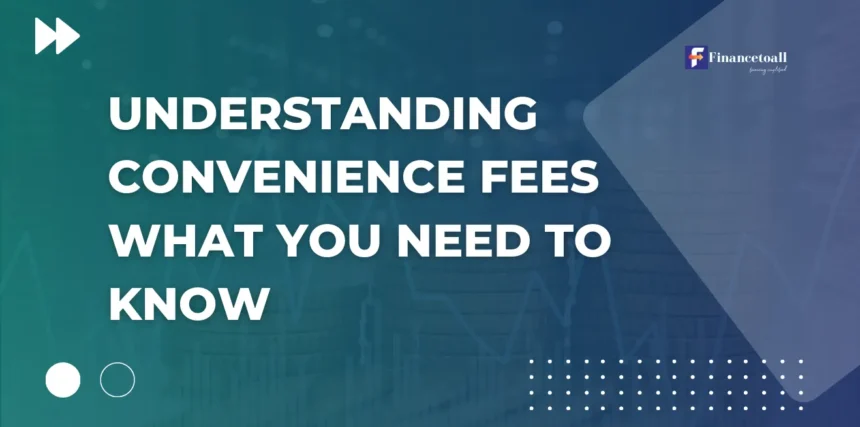In today’s fast-paced world, convenience often comes at a cost, and this is where a convenience fee comes into play. When businesses offer the option to pay online, by credit card, or through other digital methods, they sometimes charge a convenience fee. While this fee may frustrate consumers, it serves a specific purpose for businesses. In this article, we’ll explore what a convenience fee is, why it exists, how it impacts both consumers and businesses, and how it can be avoided.
Key Takeaways
What is a Convenience Fee?
A convenience fee is an extra charge businesses apply when customers choose to pay using an alternative method that is deemed more convenient. For example, if a company typically accepts payments in person but offers an online option, they may add a convenience fee for the online transaction. This fee helps businesses offset costs associated with specific payment methods, such as credit card processing.
Why Do Businesses Charge a Convenience Fee?
Businesses impose convenience fees to cover additional expenses tied to certain payment methods. These fees often arise when customers opt for more convenient payment options, like using a credit card instead of paying by cash or check. Credit card transactions, for instance, involve processing fees, and businesses pass this cost on to consumers through the convenience fee.
Additionally, the fee compensates for the convenience offered to the customer, such as saving time and effort by paying online or over the phone, rather than in person.
Types of Transactions That Include Convenience Fees
Convenience fees are applied across various types of transactions, including:
- Online purchases: Businesses often charge a fee for using a credit card or online payment gateway, such as when buying concert tickets or booking flights.
- Utility bill payments: Many utilities charge a convenience fee for digital payments, as opposed to traditional methods like mailing a check.
- Ticket bookings: Airlines, movie theaters, and event organizers frequently add these fees when customers buy tickets through their online platforms.
Difference Between a Convenience Fee and a Surcharge
It’s important to differentiate between a convenience fee and a surcharge. While both add costs to a transaction, they serve different purposes. A surcharge is specifically added to cover the expense of credit card processing fees. A convenience fee, on the other hand, applies when a customer opts to use a different, often more convenient payment method than what the business typically offers.
For example, if you pay online for an event ticket when the default option is to buy in person, you may face a convenience fee. In contrast, a surcharge would be an extra charge on top of your transaction for using a credit card.
Consumer Perspective: Frustration and Transparency
From the consumer’s perspective, convenience fees can be a source of frustration. Many customers question why they should pay extra for using a method they find easier and faster. Transparency is key in this area. When businesses clearly disclose the fee before the transaction is finalized, consumers are more likely to accept it. However, unclear or hidden fees can lead to dissatisfaction.
Consumers can avoid these fees by opting for alternative payment methods, such as paying in person, using a debit card, or paying with cash if these options are available.
Regulatory and Legal Considerations
The legality of convenience fees varies depending on the region. For example, in the U.S., credit card companies have different rules on when businesses can charge convenience fees. In some states, these fees are restricted or banned altogether. For businesses, it’s crucial to follow these regulations to avoid legal issues and potential penalties.
Business Perspective: Why Convenience Fees Matter
From a business standpoint, convenience fees serve as a way to offset the costs of offering multiple payment options. Digital platforms, fraud prevention, and credit card processing all come with added expenses. By charging a convenience fee, businesses ensure they do not incur significant losses when providing these services.
For some companies, convenience fees go beyond cost recovery and become a source of additional revenue. However, businesses must be cautious. Charging too high a fee can drive customers away, especially when competitors offer fee-free payment options.
Impact on Customer Relationships
Convenience fees can have a direct impact on customer satisfaction and loyalty. While some consumers are willing to pay extra for convenience, others may feel nickel-and-dimed by the added costs. If a business heavily relies on convenience fees, it risks alienating customers who might seek alternatives with lower or no fees.
The Future of Convenience Fees: Emerging Payment Methods
As technology evolves, so do payment methods. With the rise of mobile wallets, cryptocurrencies, and other digital payment platforms, businesses may need to reconsider how they apply convenience fees. These new payment methods could reduce transaction costs, potentially eliminating the need for such fees altogether. The future may see fewer convenience fees as competition and regulations push businesses toward more consumer-friendly practices.
Best Practices for Businesses
For businesses, transparency and fairness are essential. Companies should always:
- Clearly disclose fees upfront: Inform customers of any convenience fees before they complete the transaction, avoiding surprises.
- Provide fee-free options: Allow customers to choose fee-free payment methods, such as paying in person, with cash, or through bank transfers.
By adopting these practices, businesses can maintain trust and avoid customer dissatisfaction.
Credit Card Company Policies on Convenience Fees
Credit card companies have specific policies governing the use of convenience fees by businesses. These policies vary depending on the card network (Visa, Mastercard, American Express, etc.) and often dictate when and how businesses can charge these fees. Here’s a breakdown of some common guidelines from major credit card companies:
1. Visa
- Convenience Fee Rules: Visa allows merchants to charge a convenience fee only when the payment method offers a different or non-standard option. For example, a business that typically accepts in-person payments may charge a convenience fee for accepting payments online or over the phone.
- Fee Transparency: The fee must be disclosed clearly before the transaction is processed, and it should be a flat fee, not a percentage of the transaction.
- Restricted Use: Visa’s policy prohibits charging convenience fees for payments made in traditional face-to-face retail environments (e.g., in-store purchases).
2. Mastercard
- Convenience Fee Policies: Mastercard allows merchants to charge convenience fees, but only for payments made in non-traditional methods, such as online or phone transactions. The fee must be a flat amount rather than a percentage.
- Specific Service Requirement: The convenience fee must only apply to a specific service where paying via a different channel (like online) is deemed more convenient than the standard in-person method.
- Full Disclosure: Merchants must fully disclose the convenience fee to the consumer before the transaction is processed, ensuring transparency.
3. American Express
- Flexible but Regulated: American Express allows merchants to charge a convenience fee but doesn’t have as stringent rules as Visa or Mastercard. However, like others, the fee must be clearly disclosed to the customer before the transaction is completed.
- No Surcharge: While American Express allows convenience fees, they have stricter policies against surcharges (additional fees for using the card itself), which are separate from convenience fees.
4. Discover
- Similar to Visa and Mastercard: Discover allows merchants to charge a convenience fee for transactions where a non-traditional payment method is used (such as online or over the phone).
- Transparency Required: The fee must be disclosed to the customer upfront and must be fixed, not a percentage of the transaction.
General Guidelines for Convenience Fees by Credit Card Networks:
- Only for Non-Traditional Payments: Convenience fees are generally allowed only when customers use a payment method that is not the merchant’s standard method. This is often when paying online, over the phone, or via a mobile app when the usual payment option would be in-person.
- Flat Fee: Most credit card networks require the fee to be a fixed amount, not a percentage of the transaction value.
- Clear Disclosure: Businesses must clearly inform customers about the convenience fee before completing the payment.
- Prohibited in Certain Situations: Convenience fees are not allowed in typical retail or face-to-face purchases where using a credit card is the norm.
How Consumers Can Avoid Paying Convenience Fees
Consumers can avoid convenience fees by choosing alternative payment options. For instance, paying in person, using a debit card, or sending a check may save money compared to using a credit card or paying online. Some consumers may also find fee-free options by using different service providers or third-party payment platforms.
Global Comparison: How Other Countries Handle Convenience Fees
Convenience fees differ worldwide. In Europe, for example, regulations are stricter on surcharges and fees, giving consumers more protection. In contrast, in the U.S. and parts of Asia, convenience fees are more widely accepted and vary based on local laws. It’s essential for both consumers and businesses to understand how convenience fees work in their respective regions.
Examples of Businesses Charging Convenience Fees
Well-known companies often charge convenience fees, especially in sectors like ticketing, travel, and entertainment. For instance:
- Ticketmaster and other ticketing platforms charge convenience fees for online bookings.
- Airlines may impose fees for booking flights online instead of through a physical ticket counter.
- Utilities often apply convenience fees when customers pay bills using credit cards or online portals.
Note: An example of a convenience fee can be seen when purchasing concert or event tickets online through platforms like Ticketmaster. Typically, if you buy a ticket directly at the venue’s box office, you won’t be charged any extra fees. However, if you choose to purchase the ticket online for the convenience of securing it from home, Ticketmaster may add a convenience fee to cover the costs of processing the transaction and providing the online service.
For instance, if the ticket price is $50, Ticketmaster might charge an additional $5 as a convenience fee, making your total $55. This fee is meant to compensate for the “convenience” of purchasing the ticket through an easier, quicker method than visiting the box office in person.
How to Avoid Convenience Fees
There are several strategies consumers can use to avoid paying convenience fees. While convenience fees are often applied to make transactions easier for customers (like online payments or over-the-phone purchases), savvy consumers can avoid them by choosing alternative payment methods or platforms. Here are some effective ways to steer clear of convenience fees:
1. Pay In-Person
- Visit the store or office: If possible, visit the merchant’s physical location to pay in person. For instance, many utility companies and ticketing services waive convenience fees if you make the payment at their office or retail counter.
- Cash or Check Payments: When paying in person, using cash or checks can help you avoid fees that are typically charged for card or online payments.
2. Use Fee-Free Payment Methods
- Bank Transfers or ACH Payments: Some businesses offer bank transfer options, such as ACH (Automated Clearing House) payments, which are often free compared to using a credit card. Many utility companies or government agencies provide this option.
- Debit Card Payments: Some merchants don’t charge convenience fees for payments made with a debit card, as opposed to a credit card. Check if your merchant offers this option.
- Bill Pay Services: Many banks offer a free bill pay service that allows you to set up payments directly from your bank account to the merchant, avoiding convenience fees associated with credit card transactions.
3. Use Alternative Payment Providers
- Third-Party Payment Apps: Some services, like PayPal or Venmo, allow you to make payments without charging additional fees. Check if your merchant accepts these methods.
- Mobile Payment Apps: Some businesses accept mobile payment services like Apple Pay, Google Pay, or Samsung Pay, which might not carry convenience fees depending on the business’s policies.
4. Pay in Advance
- Avoid last-minute payments: Convenience fees often apply when you’re paying bills last minute using expedited services like phone or online payment. To avoid these fees, plan ahead and pay before the due date via check or free bank transfer.
- Mail your payment: Sending a check via mail is typically fee-free. Just ensure you mail it with enough time for the payment to be processed before the deadline.
5. Look for Fee-Free Alternatives
- Compare service providers: Some companies don’t charge convenience fees, especially in competitive industries like airlines or ticketing platforms. Shopping around for providers with no fees can save you money.
- Use a Different Service: When booking tickets, some platforms like Eventbrite or StubHub might offer lower or no convenience fees compared to others like Ticketmaster. Explore alternative services that may charge lower fees or offer promotions.
6. Choose Paperless Billing with Automatic Payments
- Set up auto-pay: Many utility companies and service providers offer discounts or waive convenience fees if you sign up for automatic monthly payments through your bank account or debit card.
- Enroll in paperless billing: Some companies incentivize paperless billing by reducing fees or eliminating them when customers agree to receive and pay bills electronically.
7. Use Credit Cards with Perks or Fee Waivers
- Cashback or Rewards Credit Cards: While this doesn’t eliminate the fee, using a credit card that offers cashback or rewards points can help offset the convenience fee by giving you a portion of the money back.
- Special Credit Card Partnerships: Some credit card companies partner with businesses to waive fees for certain types of transactions. Check if your card offers any special promotions that eliminate or reduce convenience fees.
8. Negotiate with the Merchant
- Request a Waiver: In some cases, especially with smaller businesses or service providers, you can negotiate the convenience fee or ask for it to be waived. Simply inquire if there’s a fee-free option or if they can waive the charge as a courtesy.
- Bundle Services: Some businesses might be willing to waive convenience fees if you bundle services or products together, creating a more significant transaction that justifies waiving the fee.
9. Pay via Traditional Methods
- Pay by Mail: Sending a check or money order by mail avoids the digital processing costs associated with online transactions. Ensure you allow for enough time for the mail to arrive and be processed before the due date.
- Pay in Installments: Some businesses offer fee-free installment options or financing plans that might help you spread the cost over time without facing additional convenience fees.
10. Watch for Promotions or Discounts
- Limited-time offers: Occasionally, companies run promotions where they waive convenience fees for specific periods. Keep an eye on offers or sign up for email notifications from businesses to learn when these promotions occur.
- Seasonal Discounts: Some companies may offer convenience fee waivers during busy seasons or holidays, so it’s worth watching for such opportunities.
Conclusion
Convenience fees have become a common part of the modern payment landscape, but they remain a point of contention for many consumers. By understanding why these fees exist, how they work, and how to avoid them, consumers can make more informed choices. Meanwhile, businesses must balance the need to recover costs with maintaining customer satisfaction. As payment methods continue to evolve, convenience fees may eventually become a thing of the past—or at least less common.
FAQ on Convenience Fees
Q1: What is a convenience fee?
A convenience fee is an extra charge applied by a business when a customer uses a more convenient payment method, such as paying online or over the phone, rather than the business’s standard payment method, like paying in person.
Q2: Why do businesses charge convenience fees?
Businesses charge convenience fees to cover the additional costs associated with offering certain payment methods, such as credit card processing fees, fraud prevention, and maintaining digital payment platforms.
Q3: What types of transactions typically include convenience fees?
Convenience fees are often applied to online purchases, ticket bookings (e.g., airlines or concerts), utility bill payments, and government services when paid by credit card or via non-standard methods like over the phone.
Q4: How is a convenience fee different from a surcharge?
A convenience fee is charged for using an alternative payment method, like online or phone payments, while a surcharge is an added cost specifically for credit card transactions. Surcharges apply directly to the use of a credit card, whereas convenience fees cover the cost of using a more convenient payment option.
Q5: Can I avoid paying convenience fees?
Yes, you can avoid convenience fees by using alternative payment methods like paying in person, via check, or through fee-free options such as ACH payments or bank transfers. Some businesses also waive fees for payments made with a debit card or when you enroll in automatic payments.
Q6: Are convenience fees legal?
Yes, convenience fees are legal in most cases, but they must comply with credit card company policies and local regulations. Some U.S. states restrict or regulate convenience fees, and businesses are required to disclose these fees to consumers upfront before the transaction is completed.
Q7: Do all credit card companies allow convenience fees?
Most credit card companies, including Visa, Mastercard, American Express, and Discover, allow convenience fees, but they impose specific rules. These fees typically apply to non-standard payment methods (e.g., online payments), must be clearly disclosed, and are usually flat amounts, not percentages of the transaction.
Q8: Can businesses charge a convenience fee for in-person payments?
No, credit card companies like Visa and Mastercard generally prohibit businesses from charging a convenience fee for traditional face-to-face, in-person transactions. The fee can only be applied to alternative payment methods such as online or phone transactions.
Q9: What can I do if I feel a convenience fee is unfair or hidden?
If you believe a convenience fee was unfair or not disclosed properly, you can contact the business and request a waiver. In some cases, companies may agree to remove or reduce the fee. If the issue persists, you can escalate it by reporting the business to your credit card company or relevant consumer protection agency.
Q10: Do businesses offer any promotions or discounts to avoid convenience fees?
Yes, some businesses offer promotions or discounts that waive convenience fees, especially during special events, holiday seasons, or limited-time offers. You can also sign up for automatic payments or paperless billing to reduce or avoid these fees.








